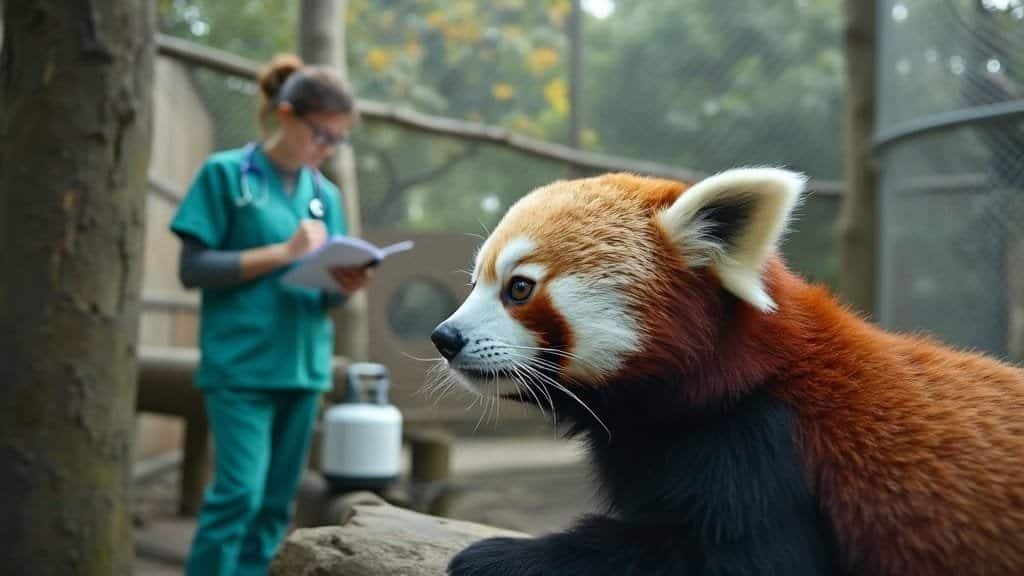Introduction
Respiratory infections are a significant health concern for red pandas in captivity, stemming from a combination of environmental factors, pathogens, and stress
These illnesses can be challenging to manage, requiring diligent care and preventive measures to ensure the animals’ well-being. By understanding the causes, such as pathogen exposure, enclosure conditions, and immune response, zoos can take proactive steps to mitigate risks
This article explores the reasons red pandas contract respiratory infections in captivity, the symptoms to watch for, and the strategies used to treat and prevent these illnesses
Causes of Respiratory Infections in Captive Red Pandas
Respiratory infections in captive red pandas arise from a combination of factors, including exposure to pathogens, environmental stressors, and seasonal changes. Understanding these causes is critical for preventing and managing illnesses in zoo settings
Common Pathogens Linked to Red Panda Respiratory Illnesses
Several pathogens are known to cause respiratory infections in red pandas
Bacteria such as Bordetella bronchiseptica and Pasteurella multocida are commonly implicated, while viral agents like the canine distemper virus (CDV) and feline calicivirus (FCV) have also been identified in cases of respiratory illness
Fungal infections, such as those caused by Aspergillus species, can occur when red pandas are exposed to moldy bedding or damp environments. These infections can lead to serious complications if not promptly treated
Pathogen exposure often occurs when red pandas share space with other animals or are exposed to contaminated environments. Infections can spread through direct contact, airborne particles, or contaminated food and water
Environmental Stressors and Their Impact on Respiratory Health
Environmental conditions in captivity can significantly influence the risk of respiratory infections in red pandas. Poor ventilation in enclosures increases the concentration of airborne pathogens and irritants, making it easier for infections to develop
Similarly, high humidity or damp conditions promote the growth of fungi and bacteria, further raising the risk of illness
Temperature fluctuations also pose a challenge, particularly during colder months when red pandas are more susceptible to respiratory distress. Sudden drops in temperature can weaken their immune systems, making it harder for them to fight off infections
Noise and human activity near enclosures can add stress, which weakens the immune response. Chronic stress may leave red pandas more vulnerable to respiratory pathogens, emphasizing the importance of maintaining a calm, stable environment for their care
Seasonal Changes and Increased Risk of Respiratory Infections
Seasonal changes play a significant role in red panda respiratory health. During colder months, red pandas may spend more time in enclosed shelters, where limited airflow increases their exposure to pathogens
Additionally, immune responses can be compromised during periods of extreme cold, making it harder for red pandas to resist infections
Spring and fall, when humidity levels fluctuate, can also create conditions conducive to fungal and bacterial growth. These seasonal dynamics necessitate proactive health monitoring and environmental management to minimize risks
Understanding the interplay of pathogens, environment, and seasonal factors is essential for addressing the root causes of respiratory infections in captive red pandas
By identifying these triggers, zookeepers and veterinarians can take targeted measures to prevent illness and ensure the health of these animals
Preventing and Managing Respiratory Infections in Zoos
Respiratory infections in red pandas can significantly impact their health and quality of life. Early detection, preventive measures, and effective treatment strategies are essential for managing these illnesses in captivity
Symptoms and Early Detection of Respiratory Issues in Red Pandas
Identifying respiratory infections early is crucial for successful treatment. Common symptoms in red pandas include:
- Nasal discharge or sneezing
- Labored or noisy breathing
- Coughing or wheezing
- Lethargy and reduced activity levels
- Decreased appetite or difficulty eating
Behavioral changes, such as hiding more frequently or avoiding interaction, may also indicate discomfort or illness. Zookeepers and veterinarians closely monitor red pandas for these signs, conducting routine health checks to detect subtle changes in behavior or physical condition
Diagnostic tools such as radiographs, blood tests, and nasal swabs can confirm the presence of an infection and identify the specific pathogen involved. This information is critical for tailoring treatment plans to the individual animal’s needs
Preventive Measures to Reduce Illness in Captivity
Zoos implement a range of strategies to minimize the risk of respiratory infections in red pandas. Key measures include:
Optimizing Enclosure Design: Ensuring proper ventilation reduces the concentration of airborne pathogens. Temperature and humidity controls help maintain a stable environment, while drainage systems prevent damp conditions that could foster fungal growth
Maintaining Cleanliness: Regular cleaning of enclosures, bedding, and feeding areas reduces the presence of harmful bacteria and fungi. Using hypoallergenic materials for bedding and avoiding mold-prone substrates further reduces risks
Quarantine and Vaccination: Newly introduced red pandas are often quarantined to prevent the spread of pathogens. Vaccination programs protect against common viral threats like canine distemper and feline calicivirus, which can cause severe respiratory illness
Enrichment to Reduce Stress: Providing a stimulating environment with climbing structures, hiding spaces, and enrichment activities helps minimize stress, which is a significant factor in immune suppression
Regular Health Monitoring: Routine veterinary exams and fecal tests help track the health of red pandas and identify potential issues before they escalate into serious illnesses
Treatment Options for Red Pandas With Respiratory Infections
When a respiratory infection is detected, zoos act quickly to provide treatment. Antibiotics or antifungal medications are commonly prescribed, depending on the pathogen involved
Supportive care, such as fluid therapy and nutritional support, ensures that the animal remains hydrated and maintains its strength during recovery
Nebulizers and humidifiers may be used to ease breathing by delivering medicated aerosols directly to the respiratory tract. In severe cases, red pandas may require hospitalization for intensive care, including oxygen therapy or intravenous medications
Rehabilitation is also an essential part of recovery. Post-treatment, red pandas are often kept in quieter, warmer enclosures to promote healing and reduce stress. Regular follow-ups ensure that the infection has fully resolved and that no long-term complications have arisen
By combining early detection, preventive care, and effective treatment, zoos can significantly reduce the impact of respiratory infections on red pandas, improving their overall health and welfare in captivity
Comparative Risk of Respiratory Infections: Captivity vs. the Wild
The prevalence of respiratory infections in red pandas varies significantly between captive and wild populations due to differences in environmental exposure, pathogen presence, and stress levels. Understanding these differences helps refine conservation strategies for both settings
Factors Increasing Susceptibility in Captive Red Pandas
Red pandas in captivity face unique challenges that can heighten their risk of respiratory infections. Enclosed environments, while designed for comfort, may inadvertently concentrate airborne pathogens, especially if ventilation is inadequate
Proximity to other animals, including non-native species, increases the likelihood of cross-species pathogen transmission
Stress is another significant factor in captive environments. Activities such as transportation, enclosure changes, or high visitor traffic can suppress immune function, making red pandas more vulnerable to illness
Additionally, seasonal fluctuations in temperature and humidity within captive settings may exacerbate respiratory health issues
While zoos take extensive measures to mitigate these risks through hygiene protocols, vaccinations, and veterinary care, the managed nature of captivity inherently exposes red pandas to some health risks not encountered in the wild
How Wild Red Pandas Avoid or Encounter Similar Pathogens
In the wild, red pandas face a different set of risks for respiratory infections. While they benefit from open-air environments with less pathogen concentration, they are not immune to disease
Wild red pandas may encounter pathogens through contact with other wildlife or contaminated resources, such as water sources
Cold and wet conditions in their natural habitats, particularly at high altitudes, can weaken their immune systems and make them susceptible to bacterial or fungal infections. However, wild red pandas generally avoid areas with high human activity, reducing their exposure to anthropogenic pathogens
The relative rarity of respiratory infections in wild red pandas compared to their captive counterparts underscores the importance of natural ventilation and low-stress conditions in their care
Success Stories in Managing Respiratory Health in Zoos
Zoos worldwide have implemented successful programs to manage respiratory health in red pandas
For instance, the Smithsonian National Zoo uses advanced air filtration systems in red panda enclosures to maintain optimal air quality. Their efforts have significantly reduced the incidence of airborne infections
In another example, the Woodland Park Zoo in Seattle integrates routine health screenings with enrichment activities designed to lower stress and boost immune function
These initiatives have been instrumental in reducing respiratory illness rates and improving overall health outcomes for their red panda population
Zoos in colder climates, such as Toronto Zoo, provide insulated shelters with controlled humidity levels to protect red pandas from extreme winter conditions. This approach minimizes the impact of seasonal weather changes on respiratory health
By learning from these successes, other institutions can adopt best practices to ensure the well-being of red pandas in captivity and support efforts to maintain healthy populations in the wild
Conclusion
Respiratory infections in captive red pandas are influenced by a combination of pathogens, environmental factors, and stress levels
While the risks are higher in captivity due to proximity to other animals, enclosed environments, and human activity, proactive measures such as optimized enclosure design, routine health monitoring, and vaccination programs can significantly reduce these risks
Comparing the respiratory health challenges faced by captive and wild red pandas highlights the importance of providing naturalistic, stress-free environments in zoos
Lessons learned from managing respiratory infections in captivity also contribute to the broader understanding of red panda health, benefiting conservation efforts for wild populations
Through early detection, effective treatment, and preventive care, zoos can enhance the welfare of captive red pandas and ensure that these charismatic animals thrive in managed care while supporting their survival in the wild





